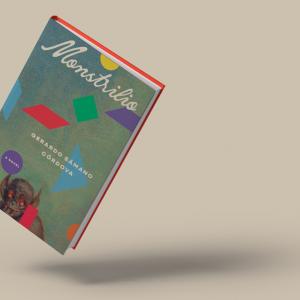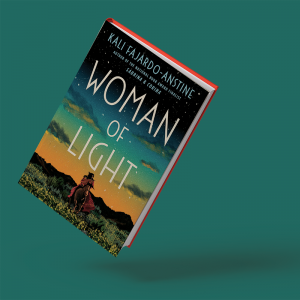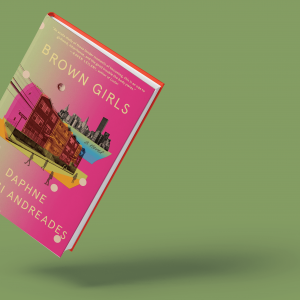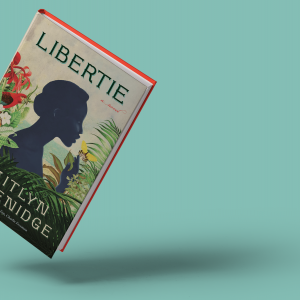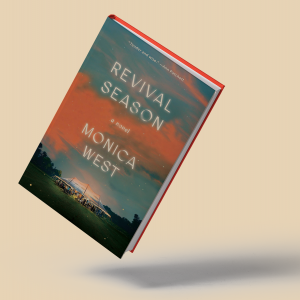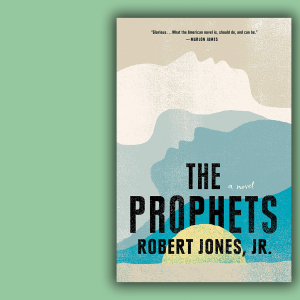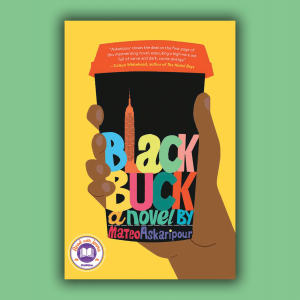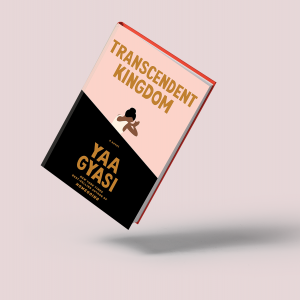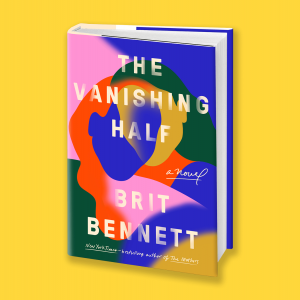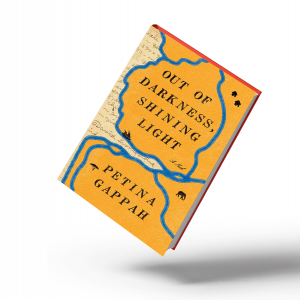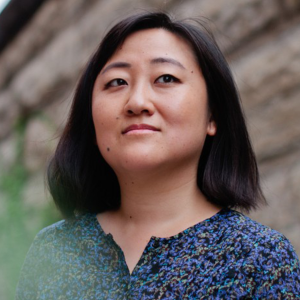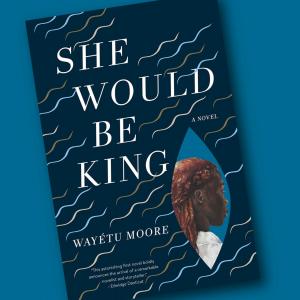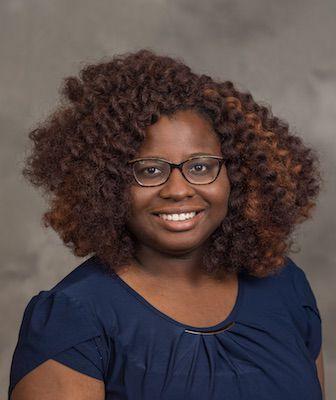
Elinam Agbo earned an M.F.A. from the University of Michigan's Helen Zell Writers' Program. Born in Ghana, she grew up in the U.S. Midwest.
Posts By This Author
‘Monstrilio’ Asks Us: What Is More Human Than This?
Part family drama, part queer coming-of-age story, Sámano Córdova’s debut novel navigates the complexities of grief.
ON A BRIGHTLY lit stage in Berlin, a performing artist drapes her dead son’s pajamas over her lap and begins to cry. She cries “loud and unabashed” until her ponytail starts to unravel, and her face becomes swollen and red. Soon, the audience begins to cry too.
The artist is Magos, mother to Santiago, the boy who dies in the opening pages of Gerardo Sámano Córdova’s novel Monstrilio. When Santiago dies, his parents — Magos and Joseph — begin to drown in their grief. But where Joseph isolates himself, weeping endlessly, Magos does something strange. She cuts out a piece of her dead son’s lung, leaves Joseph, and retreats to her mother’s house in Mexico City.
Part family drama, part queer coming-of-age story, Sámano Córdova’s debut gracefully wields its horror elements while navigating the complexities of grief. Structurally, the novel unfolds in four unique perspectives: Magos, Lena, Joseph, and M. After Magos learns about a folktale in which a dead girl’s heart grows into a young man, she sequesters herself in her mother’s house and feeds the lung pork and beef. She doesn’t clean or air out the room. Instead, she uses her odor as a shield, to keep her loved ones away from the lung, to protect its growth. This moment captures the overwhelming nature of Magos’ grief, but it also foreshadows the extent to which she will go to protect what she has left of Santiago.
A New American Western
'Woman of Light' highlights the triumphs and struggles of a people surviving under white colonial violence.
PRIMARILY SET IN 1930s Denver, Kali Fajardo-Anstine’s debut novel, Woman of Light, is a deeply immersive story about the survival and legacy of an Indigenous Chicano family. When a violent mob attacks him for having a relationship with a white woman, Diego Lopez flees the city, leaving his younger sister, Luz Lopez, with their aunt Maria Josie. But working as a laundress isn’t enough to keep a roof over their heads, so Luz gets a job as a typist for a local Greek lawyer. When a cop kills a Mexican factory worker, Luz’s boss David takes on the case, and Luz is exposed to the inner workings of an unjust system.
Epic in scope, the novel covers five generations. While we focus mainly on Luz and Diego’s timeline in the 1930s, we also get brief glimpses of the people who came before them. There is Desiderya Lopez, the Sleepy Prophet of Pardona Pueblo, who finds an abandoned newborn and raises him as her own. This child is Pidre Lopez, who later departs Pardona after Desiderya’s death. In the town of Animas, Pidre falls in love with the widow and sharpshooter Simodecea Salazar-Smith when he recruits her for his performing theater. Together, they run the vibrant business and raise their daughters Sara and Maria Josie until tragedy strikes with the arrival of white prospectors.
Those Who Live With Loss Must Cope
'The Swimmers' isn’t a ghost story, but the characters are certainly haunted.
LET'S SAY YOU are a third of the way through Julie Otsuka’s latest book, The Swimmers, and someone asks you to describe the story. If you have encountered her second novel, The Buddha in the Attic, you might comment on the familiar reliability of the collective “We,” the prevalence of lists, the cataloguing of characters’ habits and choices.
But if you prefer to be concise (so you can return to your reading), you would say the novel is about a group of swimmers who belong to an underground pool in their town. Above ground, they struggle with “bad backs, fallen arches, shattered dreams, broken hearts, anxiety, melancholia, anhedonia,” among other afflictions. But down below, in the pool, they can rely on the consistency of lanes, their lap counts, and their rules. They can even tolerate occasional rule breakers and bad management. Everything makes sense until a mysterious crack appears at the bottom of the pool.
Soon, one crack develops into many. When experts cannot find the origin of the anomaly, it leads to one conclusion: The pool must close.
‘Even in Song, We Become Fluent in the Language of Our Colonizers.’
The new novel 'Brown Girls' explores the ways we return — in flesh, in memory, and in spirit — to the places and people who made us.
WHISPER NETWORKS. The Greek muses. Immigrant aunties. Women, in groups, are loud and gripping storytellers. Daphne Palasi Andreades’ debut Brown Girls confirms this. In eight immersive sections, the novel chronicles the coming-of-age of the titular brown girls, mainly second-generation immigrants raised in the “dregs of Queens” (N.Y.).With the first-person plural narration, we follow a chorus that aims to reclaim the voices they lost at various junctures in their lives. After all, what demands a shout if not systemic silence?
The brown girls experience erasure early. Their teachers mistake Michaela for Naz, Nadira for Anjali. They snap at Sophie who is Filipino, but call her Mae, who is Chinese. To mold themselves into girls who are worthy of visibility, the brown girls begin to erase themselves. They lighten their skin. They quiet their rage. After middle school, education takes some of them away from Queens. They wrestle with the changes it brings. “Dutifully, we reposition our tongues,” they tell us. “Even in song, we become fluent in the language of our colonizers. Our English, impeccable. Our mother tongues, if we were taught them at all, become atrophied muscles, half-remembered melodies.”
The Price of Freedom
Colorism, freedom, and the loneliness of love in Kaitlyn Greenidge's "Libertie."
WHAT IS FREEDOM, really? When we first meet the titular narrator of Kaitlyn Greenidge’s novel Libertie, the year is 1860 and Libertie Sampson is a child in Kings County, New York, witnessing a miracle: Her mother, Dr. Sampson, raises a man escaping slavery “from the dead.” Her father, a former slave who died before her birth, named Libertie after his “longing” for “the bright, shining future he was sure was coming.” Libertie grows up watching her mother work, learning about the body’s ailments alongside the plants and remedies that can allay suffering. Perhaps this—the ability to heal, to gain access to a position other Black women could not, to guide others to life outside slavery—is the freedom Dr. Sampson envisions for her daughter, who is raised to follow in her mother’s footsteps.
But Libertie soon learns that she and her mother do not have the same privileges: Where her mother’s light skin allowed her access to medical school, Libertie’s dark skin means she cannot enter the same rooms as her mother. When white patients recoil from Libertie’s touch—and her mother does not defend or shield her—Libertie begins to lose faith in her mother’s version of freedom.
Faith, Family, and Forgiveness
Complicated characters care for one another while wrestling with the pain they perpetuate.
FOR 12 YEARS, the Hortons have spent their summers on the revival circuit, driving hundreds of miles from one small city to another. Samuel Horton, a Black Baptist preacher famous for his healing, is proud of the souls he has won for the Lord and prouder of the power he wields. Still, he yearns for miracles no one would question, that would wipe away any doubt in his ability. If only he could heal his younger daughter, Hannah, who has cerebral palsy. If only his wife could give him another son, especially after their second son, Isaiah, was stillborn. In his pride, Samuel blames the women around him for his own limitations, even as he relies on them to hold together the picture of faith he has carefully constructed.
Behind the scenes of Samuel’s performance is 15-year-old Miriam Horton, the narrator of Monica West’s Revival Season. When the novel opens, Miriam is in awe of her father’s position and power, despite questioning the limited roles women hold in her community. As she helps raise Hannah and supports her mother, she memorizes her father’s prayers and sermons, carefully stud-ying his process. She particularly envies her younger brother Caleb, who has the privilege of shadowing their father. Still, she prays that the scandal of the previous summer—when her father injured a pregnant girl he was meant to heal—does not follow them into the new season.
Their Love Belongs to Them
A review of Robert Jones Jr.'s 'The Prophets'.
ON A MISSISSIPPI plantation known as “Empty,” two young enslaved people work and live in the barn, tending to the animals and each other. Despite opposing personalities, Isaiah and Samuel fit together: Where Isaiah is soft and accommodating, Samuel is hard and unyielding. As Samuel actively fights the system that seeks to bend him, Isaiah bends to survive, even as he mourns the name that was stolen from him. While Empty constantly seeks to erase their humanity, these young men find a quiet peace in their love, which touches the community around them.
In The Prophets, Robert Jones Jr. richly renders the perspectives of the enslaved and their enslavers, allowing for a complexity that a story with a single point of view would miss. The novel contains multitudes, among them a love story, an epic, an origin story, and a spiritual journey. This formidable debut weaves the ancestral past with the characters’ present to illuminate histories, realities, and possibilities that are just beyond reach. In his testament to Black queer love and storytelling, Jones confronts questions of gender, power, and consent in the wake of the transatlantic slave trade.
As the owner of Empty, Paul’s priority is to breed more slaves, and Isaiah and Samuel’s union poses a threat to these goals. In his own attempt at survival, the slave Amos proposes a solution: In exchange for “being learned in the ways of Christ, which meant being learned in ways forbidden by law,” he would preach to his fellow slaves and instill that “docility was treasured over rebellion.” For Amos, a glimpse of freedom means access to doors that have been closed to him. But for Amos to succeed, Samuel and Isaiah must give up their ability to choose who they can love.
Doom and Success in the World of Startups
Truth, race, and satire in the novel Black Buck.
IN HIS DEBUT novel Black Buck, Mateo Askaripour tackles race in the world of startups. Doubling as a kind of self-help manual for Black people in sales, the novel’s structure and tone allow it to hold multitudes: the dark, the hopeful, the comical, the horrific. But at its heart, this is also a novel about community.
We meet Darren, a 22-year-old shift supervisor at Starbucks who lives with his mother in Bed-Stuy, Brooklyn, New York. They’re not poor, he insists, pointing to the home his mother owns. But this doesn’t negate the harsh conditions she is exposed to at her factory job. Still, life is good—and if a day is not “good,” then at least he can come home to a warm dinner with his mother, girlfriend, best friend, and the neighbor who is practically family. Darren would be content, if not for a few reminders that he could aim higher, achieve more. He was, after all, valedictorian of his class at the Bronx School of Science.
Enter Rhett, the charismatic CEO of Sumwun, a startup located on the 36th floor of the building where Darren works. When Darren smoothly attempts to sell Rhett a new drink, Rhett sees his potential and recruits him. This is how Darren becomes Buck, the first Black man at Sumwun. Racist shenanigans ensue, popular among them: Has anyone told Darren that he looks like Martin Luther King Jr.? Sidney Poitier? Dave Chapelle? Against a background of overt racism, appropriation, and consumerism, the cult-like culture of Sumwun is unforgiving. Meanwhile, the company’s mission is opaque, rife with danger and risk. What impact are they really making? Are they helping anyone? Where is all the money coming from?
When a Haunted Past Overtakes Us
’Transcendent Kingdom' by Yaa Gyasi shows that in the darkness of loss, there can be great meaning in the searching.’
IN THE NOVEL Transcendent Kingdom, Gifty is a doctoral candidate in neuroscience at Stanford University, aiming to identify the neural pathways that suppress reward-seeking behavior. She is at the lab trying to keep two mice from tearing each other apart when her mother’s pastor calls. Gifty’s mother is sick, severely depressed ever since her son, Gifty’s brother Nana, died of a heroin overdose. Now, years later, Gifty wants nothing more than to bring her mother back to life.
In her second book, author Yaa Gyasi continues to grapple with familial loss and inheritance. But while her debut novel Homegoing examined the legacy of slavery, Transcendent Kingdom follows a young woman as she recalls her immigrant family’s triumphs alongside their devastating fight with depression and addiction. Through her methodical (scientific, spiritual, and philosophical) inquiry, Gifty tries to keep their memories alive.
What happens when the past haunts and overwhelms the present? At 28, Gifty’s life is lonely lab work and rumination, a mother unresponsive save for her hum, a father so distant he is not called by name. Even when Gifty is silent, the past reverberates loudly in her relationships. If she can find answers to her research questions, perhaps one day someone could be saved from the throes of addiction. But who will save her?
The Enduring Poison of Whiteness in ‘The Vanishing Half’
A review of Brit Bennett's newest novel.
IN HER STUNNING second novel, Brit Bennett, author of The Mothers, once again examines race and kinship. This time, she interrogates the color line through the Vignes twins—their coming of age and its impact on the subsequent generation. Born and raised in the fictional town of Mallard, La., the twins dream of escaping their stifling community. At 16, they run away together. In New Orleans, a desperate choice severs their bond: Stella passes as white to get a job, then leaves her sister Desiree in order to marry a white man.
Years later, when Desiree flees an abusive marriage and returns to Mallard with her daughter, Jude, the town is shocked by the child’s color: “black as tar,” “blueblack.” Having inherited her father’s complexion, Jude looks nothing like her mother. From its opening pages, The Vanishing Half grounds us in this “strange” town that, “like any other, was more idea than place.” The idea: a community for those “who would never be accepted as white but refused to be treated like Negroes.” An idea born of a freed slave, the twins’ ancestor, as he “stood in the sugarcane fields he’d inherited from the father who’d once owned him.”
The Hypocrisy of Colonialism
A review of "Out of Darkness, Shining Light," by Petina Gappah.
IN HER LATEST novel, Petina Gappah reimagines the death of Scottish missionary and doctor David Livingstone, focusing on his African servants, the names history forgot. They are Christians, Muslims, healers, porters, women, and children: a family of strangers who band together to carry Livingstone’s body, marching more than 1,500 miles in 285 days, so his remains may be claimed in Bagamoyo, Tanzania, and returned to England.
Every name on this trip holds stories that could occupy a novel of their own. To encompass them, Gappah employs two distinct narrators: Halima and Jacob Wainwright.
Halima, the doctor’s cook, is known for her sharp tongue, which ridicules the caprice of men and repeatedly tells of her youth as a sultan’s slave. In the early days of the journey with Livingstone’s body, Halima mourns the doctor, whom she calls “Bwana (Master) Daudi,” like a paternal figure. Though the men on the journey take credit, she is the one who proposes a way to preserve the doctor’s corpse for the long road ahead.
But Halima’s love for the bwana does not prevent her from noting his contradictions. She wonders why he would leave his family to search for the source of the Nile, argues with his colonial perception of a children’s game, and questions how a man who condemns the slave trade would have one of their company whipped.
A Tale of Fevered Capitalism
Capturing the complexities of consumerist culture in Ling Ma's novel, 'Severance.'
“AFTER THE END came the Beginning.” This is how we enter the world of Ling Ma’s debut novel Severance: in the liminal space between end and possibility. In a narrative that alternates between aftermath and memory, we find a stark reflection of our present.
Protaganist Candace Chen works for a book production company, and her specialty is the acquisition of Bibles. Tedious office work. She has lost her parents, recently left a relationship, and lives alone in Manhattan when news of a spreading illness—Shen Fever—erupts. The fever begins in China, in a region that produces the Gemstone Bible, one of Candace’s specialty Bibles. Before and during this outbreak, work, for Candace, is at once sustenance and distraction.
Who can live outside capitalism? Jonathan, Candace’s ex, certainly tries. But that is not the life Candace wants—or, rather, that is not the life her immigrant parents raised her to want.
Familiar and Painful Realities
A review of ‘She Would Be King,’ by Wayétu Moore.
“FENGBE, KEH KAMBA BEH. Fengbe, kemu beh. We have nothing but we have God. We have nothing but we have each other.”
Like the voice of the wind, this song pervades the vivid landscape of Wayétu Moore’s debut novel, in which the Liberian-born writer explores the early days of Liberia, in the 1840s, through three characters: Gbessa, June Dey, and Norman Aragon.
In She Would Be King, these three impossible lives (and a country) emerge out of slavery, violence, and exile. Death eludes and “mocks” Gbessa, of the Vai people, who constantly suffers the pain of dying without its relief. Born on a cursed day, Gbessa grows up under house arrest until she is exiled. Alone in the forest, torn from her family and people, she sings, “Fengbe keh kamba beh. Femgbe, kemu beh.” The “we” of this song haunts the reality of Gbessa’s situation, and to offer a glimpse of the big picture, Moore writes: “The words ascended, joining the traveling wind, and sometimes it was as though someone were singing with her.”
And someone was. Across time, language, and distance. Ol’ Ma Famatta sits in the moon, and the slave once known as Charlotte whispers comfort in the wind as if to say loneliness is not forever, as if to promise Gbessa that she is not alone.
